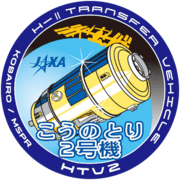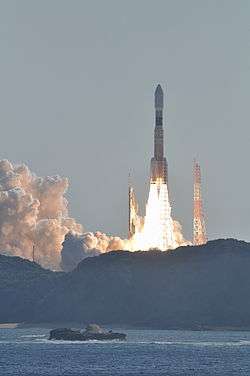Kounotori 2
 Kounotori 2 approaches the ISS on 27 January 2011 | |||
| Mission type | ISS resupply | ||
|---|---|---|---|
| Operator | JAXA | ||
| COSPAR ID | 2011-003A | ||
| SATCAT № | 37351 | ||
| Spacecraft properties | |||
| Spacecraft type | HTV | ||
| Start of mission | |||
| Launch date | 22 January 2011, 05:37:57 UTC[1][2] | ||
| Rocket | H-IIB 304 | ||
| Launch site | Tanegashima Yoshinobu 2 | ||
| Contractor | Mitsubishi | ||
| End of mission | |||
| Disposal | Deorbited | ||
| Decay date | 30 March 2011, 03:09 UTC | ||
| Orbital parameters | |||
| Reference system | Geocentric | ||
| Regime | Low Earth | ||
| Perigee | 308 kilometres (191 mi) | ||
| Apogee | 324 kilometres (201 mi) | ||
| Inclination | 51.6 degrees | ||
| Period | 90.84 minutes | ||
| Epoch | 24 January 2011[3] | ||
| Berthing at ISS | |||
| Berthing port | Harmony nadir | ||
| Berthing date | 27 January 2011[4] | ||
| Unberthing date | 19 February 2011[5] | ||
| Time berthed | 22 days | ||
| Berthing at ISS | |||
| Berthing port | Harmony zenith | ||
| Berthing date | 19 February 2011[4] | ||
| Unberthing date | 10 March 2011[5] | ||
| Time berthed | 19 days | ||
| Berthing at ISS | |||
| Berthing port | Harmony nadir | ||
| Berthing date | 10 March 2011[5] | ||
| Unberthing date | 28 March 2011[4] | ||
| Time berthed | 18 days | ||

| |||
Kounotori 2 (こうのとり2号機, "white stork"[6]), also known as HTV-2,was launched in January 2011 and was the second Japanese H-II Transfer Vehicle to resupply the International Space Station (ISS).[7] It was launched by the H-IIB Launch Vehicle No. 2 (H-IIB F2) manufactured by MHI and JAXA.[8] After the supplies were unloaded, Kounotori 2 was loaded with waste material from ISS, including used experiment equipment and used clothes. Kounotori 2 was then unberthed and separated from the ISS and burned up upon reentering the atmosphere on 30 March 2011.
Specifications
Kounotori 2 is four meters across and about 10 meters long. It consists primarily of three parts: a Propulsion Module, an Avionics Module, and a Logistics Carrier.
The propulsion module is installed at the rear of the Kounotori and is composed of the main engines for orbit change, the Reaction Control System thrusters for positioning and attitude control, fuel and oxidizing reagent tanks, and high pressure air tanks. The avionics module is installed in the center part of Kounotori, with electronic equipment for guidance control, power supply, and telecommunications data processing. The logistics carrier stores supplies.
Cargo items
Kounotori 2 carried 5.3 tonnes of cargo to ISS, consisting of 4 tonnes in the Pressurized Logistics Carrier (PLC) and 1.3 tonnes in the Unpressurized Logistics Carrier (ULC).[4] Cargo in the PLC consists of spare system components (51% of cargo weight), food (24%), science experiment materials (10%), crew commodities (8%), and water (7%).[4] It included the Kobairo (Gradient Heating Furnace) rack[9] and a Multipurpose Small Payload Rack (MSPR).
The Gradient Heating Furnace is a high-temperature electrical furnace that will be used to generate large scale, high-quality crystals from melting materials. The MSPR is a multipurpose rack that will be used for many different functions. The rack consists of three main components – a Work Volume, a Work Bench, and a Small Experiment Area. One experiment that is already planned for the Work Volume, to be launched on a later flight, is the Aquatic Habitat, which will be used to breed small fish in order to study their responses to microgravity and cosmic radiation.
Once Kounotori 2 was berthed to the ISS, both Kobairo and the MSPR were transferred into the Japanese Pressurized Module.[7][10] The installation and commissioning of these racks will initiate the 2nd phase of the Japanese Experiment Module (JEM) utilization.
Kounotori 2's Unpressurized Logistics Carrier (ULC) carried an EP (Exposed Pallet) with two US ORUs (Orbital Replacement Units) attached: an FHRC (Flex Hose Rotary Coupler) and CTC-4 (Cargo Transportation Container-4).[11] Both the FHRC and CTC-4 were transferred from Kounotori 2's EP to the space station's ELC-4 using the ISS's manipulator "Dextre".
- Gradient Heating Furnace
- Multi-purpose Small Payload Rack
- Cargo Transport Container
Operation
Scheduling of Kounotori 2 operation was affected by the Space Shuttle mission STS-133. STS-133 was originally planned to be launched in September 2010, well before Kounotori 2. After several delays, eventually STS-133 was scheduled for February 2011. Since Kounotori 2 needed to depart the ISS after the Space Shuttle to carry away the wastes from the Shuttle's cargo, Kounotori 2's schedule was changed to stay attached to the ISS for two months, close to its design limit, from the initial plan of 40 days. Also, the Dextre robot hand had to keep holding the external payload and wait for the arrival of STS-133, since STS-133 was carrying the Logistics Carrier 4 stowage platform to install the external payload.

Launch and rendezvous with ISS
.jpg)

Kounotori 2 was initially scheduled to launch on 20 January 2011, but this was postponed for two days due to a bad weather forecast. The H-IIB rocket with Kounotori 2 onboard was successfully launched from Tanegashima Space Center on 22 January 2011, 05:37:57 UTC.[1] It made its rendezvous with the space station for a subsequent docking to the Harmony node's nadir port on 27 January. The space station's Space Station Remote Manipulator System (Canadarm2) grabbed Kounotori 2 at 11:41 GMT as the vehicles flew 220 miles over the southern Indian Ocean.[12] Kounotori 2 was berthed to the space station using the Canadarm2. The Canadarm2 was controlled by Expedition 26 flight engineers Catherine Coleman and Paolo Nespoli using the Robotic Work Station (RWS) in the observatory module Cupola which provided them with increased situational awareness by enabling a 360 degree view of the exterior of the station.[13] The berthing was completed at 14:51 GMT after bolts engaged inside the berthing port to firmly attach the spacecraft to the space station.
Operation while berthed to ISS
While Kounotori 2 was berthed to the ISS, the crew entered and removed the supplies from the HTV PLC.[4]
Space shuttle mission STS-133 arrived while Kounotori 2 was berthed to ISS. To avoid interference with the payload bay of the shuttle, Kounotori 2 was relocated from Harmony Nadir port to Zenith port.[4] This was done on 18 February,[14] before the launch of STS-133.[15]
After space shuttle Discovery departed the International Space Station and the STS-133 mission was completed, on 10 March 2011, the ISS crew robotically relocated Kounotori 2 back to the nadir port of the Harmony module. The moving operation began at 11:49 UTC. The spacecraft was attached to the Common Berthing Mechanism (CBM) at Harmony's Earth facing nadir port at 16:19 UTC. The CBM bolts were fastened at 17:20. The five-hour-long moving operation was completed when the space station crew completed the connections of the electrical cables/lines between the Kounotori's Pressurized Logistics Module (PLC) and the Harmony module at 18:55 UTC.[16]
During the stay of Kounotori 2 in the ISS, the M-9.0 earthquake occurred on 11 March. The ground control center in Tsukuba was damaged, and the monitoring operation had to be handed over temporarily to NASA.[17] Mission control room resumed the operation on 22 March.[18]
Crew aboard the ISS
The ISS crew upon the arrival of Kounotori 2 were the members of Expedition 26.
- Scott J. Kelly, NASA, Commander
- Aleksandr Kaleri, RSA
- Oleg Skripochka, RSA
- Dmitri Kondratyev, RSA
- Catherine Coleman, NASA
- Paolo Nespoli, ESA

Departure and reentry
After an extended two-month stay, on 28 March, Kounotori 2 was detached from the docking port by robotic hand at 15:29 UTC and released at 15:46 UTC.[19] It reentered the Earth's atmosphere at around 03:09 UTC on 30 March.[20] The reentry was logged by a Reentry Breakup Recorder, one of two carried to the station; the other was installed in the Johannes Kepler ATV and was intended to record its return, but failed to make contact following reentry; consequently, no data was retrieved.[21][22]
See also
- H-II Transfer Vehicle
- HTV-1
- Automated Transfer Vehicle
- Progress (spacecraft)
- List of unmanned spaceflights to the ISS
References
- 1 2 JAXA, MHI (22 January 2011). "Launch Result of H-IIB Launch Vehicle No. 2 with KOUNOTORI2 (HTV2) Onboard". Retrieved 1 December 2013.
- ↑ McDowell, Jonathan. "Launch Log". Jonathan's Space Page. Retrieved 30 November 2013.
- ↑ McDowell, Jonathan. "Satellite Catalog". Jonathan's Space Page. Retrieved 30 November 2013.
- 1 2 3 4 5 6 7 JAXA (20 January 2011). "HTV2 (KOUNOTORI 2) Mission Press Kit" (PDF). Retrieved 21 January 2011.
- 1 2 3 Bauduin, Pierre (18 January 2012). "Cargo spacecraft "HTV-2" (Kounotori 2)". Retrieved 14 June 2012.
- ↑ JAXA (11 November 2010). ""KOUNOTORI" Chosen as Nickname of the H-II Transfer Vehicle (HTV)". JAXA. Retrieved 23 December 2010.
- 1 2 Pete Harding (20 October 2010). "ISS Prepares for Busy Upcoming Year of Logistics Operations". NASASpaceFlight.com. Retrieved 28 October 2010.
- ↑ JAXA. "H-ⅡB Launch Vehicle" (PDF). Archived from the original (PDF) on March 26, 2014. Retrieved 14 November 2010.
- ↑ JAXA. "The Gradient Heating Furnace". Retrieved 14 November 2010.
- ↑ "宇宙ステーション補給機2号機(HTV2)の準備状況について" (in Japanese). JAXA. 27 October 2010. Retrieved 28 October 2010.
- ↑ NASA (3 September 2010). "NASA Payloads Take First Trip to Station Aboard Japanese Rocket". Retrieved 13 November 2010.
- ↑ Stephen Clark (2011-01-27). "Japanese cargo craft reaches International Space Station". Spaceflight Now. Retrieved 2011-02-04.
- ↑ NASA (27 January 2011). "Crew Attaches Japanese Resupply Vehicle to Station". Retrieved 4 February 2011.
- ↑ "KOUNOTORI2 Relocation Completed". JAXA. 19 February 2011. Retrieved 19 February 2011.
- ↑ Pete Harding (7 January 2011). "STS-133 launch slip impacts HTV-2 and ATV-2 missions". NASASpaceflight.com. Retrieved 23 January 2011.
- ↑ "KOUNOTORI2 Returns to Original Berthing Port". JAXA. 11 March 2011. Retrieved 13 March 2011.
- ↑ Stephen Clark (11 March 2011). "Japanese quake disrupts space station operations". SpaceFlightNow.com. Retrieved 15 March 2011.
- ↑ 筑波宇宙センターでの「きぼう」および「こうのとり」の運用管制再開 (in Japanese). 22 March 2011. Retrieved 22 March 2011.
- ↑ "KOUNOTORI2 (HTV2) Leaves the ISS". JAXA. 29 March 2011. Retrieved 30 March 2011.
- ↑ "Successful Re-entry of HTV2". JAXA. 30 March 2011. Retrieved 30 March 2011.
- ↑ "ISS On-Orbit Status 03/27/11". NASA. 27 March 2011. Retrieved 30 March 2011.
- ↑ "Follow-up on the Reentry Breakup Recorder". ESA. 24 June 2011. Retrieved 10 July 2011.
External links
| Wikimedia Commons has media related to HTV-2. |
- KOUNOTORI2/H-IIB Launch Vehicle No.2 Special Site, JAXA
- KOUNOTORI2/H-IIB F2 Quick Review on YouTube. JAXA
